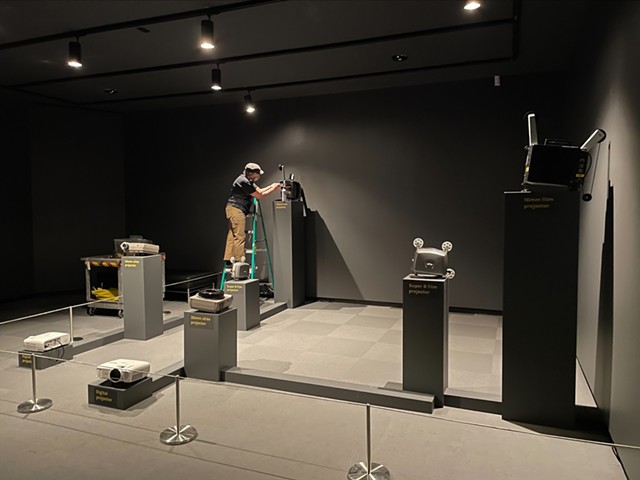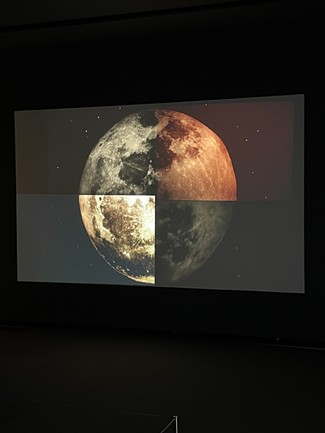The room in the Memorial Art Gallery where by Tara Merenda Nelson’s movie and video installations are screening is silent except for the whirring and clicking of devices.
The gadgets — projectors for 16mm, Tremendous 8, and slide movie, as well as high-definition video — are in fact component of the present each and every meticulously positioned for their projections to align with one a further to kind a one image.
“FourMats,” on check out by way of Aug. 8, options two of Nelson’s multimedia is effective. “End of Empire” is a tall moving image of the Kodak Tower, with each and every projection stacked up to kind a image of the legendary creating. In “Moon,” each and every projection is a quarter of the entire moon.
Aligned in this way, the stark visible variations involving the projections — like vibrancy of color, clarity of facts, and steadiness of the image — are noticeable. The outcome leaves viewers feeling as although they’re seeing the object by way of 4 diverse durations of time at the same time.
The essential word here is “feeling.” Nelson’s perform is a lot more than a easy demonstration of the progression of movie and video technological innovation. It explores the outcome the technology’s nuances have on us: how we perceive gentle and how we organize visuals to make deeper associations with what we are seeing.
In this situation, the seem of each and every form of movie or video is inextricably connected to the durations of time those people technologies ended up well-known, providing rise to connections we have, or feel we should really have, with those people days.
“This is based mostly on the Gestalt theory of group,” Nelson said as she improved out movie loops a short while ago in preparing for the up coming “performance” of the set up.
Gestalt concepts are about how we interpret visuals from the planet around us to build a entire image, and understand what we’re seeing.
Tremendous 8 movie assignments at 18 frames for each 2nd, when compared with 16mm movie, which normally runs 24 frames for each 2nd. When the High definition video information movement, it doesn’t pulse and flicker like movie. The slide, on the other hand, is a regular however image.
Nelson, the curator of moving image collections at Visible Research Workshop, said in her artist assertion that she sought to discover how folks perceive illustrations or photos and give them meaning. Her perform focuses on how that perception is influenced by the gentle that conveys the image and the darkness involving the frames, which she phone calls “the area of imagination.”
At the time she built the recordings (“End of Empire” in 2014 and “Moon” in 2015), Nelson said, she was wrapped up in comprehending abstraction and the group of visible information and facts.
“But I was also interested in movie and movie projection,” Nelson said, introducing that, as a filmmaker specializing in Tremendous 8, she was struck by how folks documented a feeling of nostalgia when they viewed Tremendous 8 films, even when it was their first time seeing one.
“Why would you sense nostalgic?” she requested. “What are you feeling nostalgic for if this is an experience you have never experienced?”
The solution, most likely, is in the affiliation we have with the seem of more mature technologies and our cultural expertise of when and how they ended up utilized. One thing filmed right now on Tremendous 8 can be mistaken for a residence motion picture from the sixties simply because of the color, clarity, and number of frames for each 2nd that our brains routinely browse as more mature tech.
Which is why Nelson’s portrait of the Kodak creating, applying 4 formats shot in 2014, appears to be to soar numerous many years as your eyes go down the tower. It is also why snapshots taken right now on a refurbished Polaroid digicam can “feel” classic.
With the moon portrait, the visible variations involving the 4 quadrants are quite straightforward. Although each and every slice of the moon is in grayscale, some wedges are brighter than many others, some facts are a lot more crisp, and, in the situation of the slide movie, the image is hotter.
But the Kodak Tower, projected in horizontal strips from the peak of the roof down to the base of the creating at street stage, has a lot more fast associations with the time durations of each and every form of movie or video.
The oldest type of movie projected — 16mm, invented by Eastman Kodak in 1923 — reveals the maximum tier, which includes the major of the tower and the sky in a amazing blue. The image is a little bit fuzzy and wobbles a little as it cycles by way of its loop.
Relocating down a tier to the Tremendous 8 — debuted by Eastman Kodak at the 1964 New York World’s Good — the image is dimmer and noticeably glints. Beneath that, the slide movie — circa 1935 — is a constant image, but fuzzy by today’s criteria. At the street stage is the High definition video: brilliant and crisp, with no jumps or flickering. Vehicles whiz by, folks move into and out of the body, and present day traffic lights and present buildings surround the base of the tower.
The lineup of formats is effective well in this purchase. Isolated in the blue sky, the major of the tower, which was built in 1914, appears to be like as although it could have been shot when 16mm movie was new. The new buildings, traffic, and cease lights at the base ended up correctly recorded with present day video technological innovation.
Almudena Escobar López, the assistant curator of media arts at the Mag, discussed that the set up was originally a functionality piece that was adapted into a lengthier-run exhibition. But a caveat of the projections is that their good quality erodes with each individual “performance,” like a vinyl report that is played around and around once more.
“The movie loops degrade each and every time that you activate the set up, and they really do not past for lengthy each and every time,” Escobar López said.
Like memory, the projections fade with time and, at some point, will turn into unreliable and lost.
“We can relate, in a way,” Nelson said, “because that is some thing we’re grappling with in the human situation.”
“FourMats” is viewable on Thursdays from 4 to 8 p.m. and Saturdays from one to 4 p.m.
Integrated in the exhibition application is “The Expanded Cinema Apply of Tara Merenda Nelson” on July 29 at 6 p.m., an online dialogue involving Nelson and curator Almudena Escobar López about Nelson’s expanded cinema practice. For a lot more information and facts, visit mag.rochester.edu.
Rebecca Rafferty is CITY’s life editor. She can be arrived at at [email protected].









More Stories
The Evolution of Filipino Sculptures
Unique Facts About Cultural Diversity of India
Art is a Reflection on Society – A Perspective